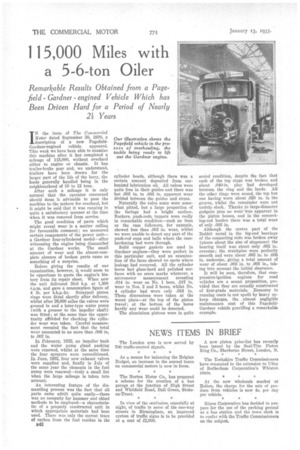115,000 Miles with a 5-6-ton Oiler
Page 56

If you've noticed an error in this article please click here to report it so we can fix it.
Remarkable Results Obtained from a Pagefield Gardner engined Vehicle Which has Been Driven Hard for a Period of Nearly 21 Years
IN the issue of The Commercial Motor dated September 30, 1930, a description of a new PagefieldGardner-engined vehicle appeared. This week we have been able to examine this machine after it has completed a mileage of 115,000, without overhaul either to engine or chassis. It has trailer-brake gear and, we understand, trailers have been drawn for the larger part of the life of the lorry, the loads generally handled being in the neighbourhood of 10 to 12 tons.
After such a mileage it is only natural that the operator concerned should deem it advisable to pass the machine to the makers for overhaul, but • it might be said that it was running in quite a satisfactory manner at the time when it was removed from service.
The good condition of parts which might reveal wear is a matter calling for favourable comment; we measured certain components of the power unite Gardner four-cylindered model—after witnessing the engine being dismantled at the Gardner works. The small amount of wear and the almost-complete absence of broken parts came as something of a surprise.
Before giving the results of our examination, however, it, would seem to be opportune to quote the engine's history from its repair sheet. When new the unit delivered 50.6 h.p. at 1,300 r.p.m. and gave a consumption figure of 4 lb. per b.h.p.-hr. Scraypoil piston rings were fitted shortly after delivery, whilst after 26,000 miles the valves were ground in and a later-type water pump (with a greaser to the impeller shaft) was fitted ; at the same time the opportunity aff6rded for checking the cylinder wear was taken. Careful measurement revealed the fact that the total wear amounted to no more than .006 in. to .007 in.
In February, 1932, an impeller bush and the water pump gland packing were renewed, whilst at the same time the four sprayers were reconditioned. In June, 1932, four new exhaust valves were supplied and, finally in July of the same year the elements in the fuel pump were renewed—truly a small list when the large mileage is taken into account.
An interesting feature of the dismantling process was the fact that all parts caffie adrift quite easily—there was no necessity for hammer and chisel methods to be employed—a characteristic of a properly constructed unit in which appropriate materials had been used. There was only the merest trace of carbon from the fuel residue in the
cylinder heads, although there was a certain amount deposited from carbonized lubrication oil. All valves were quite free in their guides and there was bat .003 in. to .005 in. apparent wear divided between the guides and stems.
Naturally the valve seats were somewhat pitted, but a large proportion of the facings had a bright surface. Rockers, push-rods, tappets were really in remarkable condition—such an item as the cam followers, for example, showed less than .003 in. wear, whilst we were unable to detect any part of the push-rod cups and balls where the casehardening had worn through.
Solid copper gaskets are used in Gardner engines—they were perfect in this particular unit, and an examination of the faces showed no spots where leakage had occurred. All the cylinder bores had glass-hard and polished surfaces with no score marks whatever, a micrometer measurement revealing .014 in. wear on No. 1 bore, .017 in. wear in Nos. 2 and 3 bores, whilst No. 4 cylinder had worn only .016 in. These dimensions were taken at the worst place—at the top of the piston travel; at the bottom of the bores hardly any wear could be detected.
The aluminium pistons were in quite sound condition, despite the fact that each of the top rings was broken and about .040-in, play had developed between the ring and the lands. All the other rings were sound, the top but one having worn about .020 in. in the groove, whilst the remainder were not unduly slack. Thanks to large-diameter gudgeon pins no wear was apparent in the piston bosses, and in the connecting-rod bushes there was a total wear of only .003 in.
Although the centre part of the Babbit metal in the big-end bearings of the connecting rods was broken away (pieces about the size of sixpences) the bearing itself was about only .002 in. oversize; the crankpins were perfectly smooth and were about .003 in. to .005 in. undersize, giving a total amount of wear of about .003 in. to .005 in., taking into account the initial clearance.
It will be seen, therefore, that compression-ignition engines for road vehicles are a sound proposition, provided that they are soundly constructed of first-grade materials. Economy in running costs is not spoilt by heavy upkeep charges, the . almost negligible maintenance cost of this PagefieldGardner vehicle providing a remarkable example.




























































































